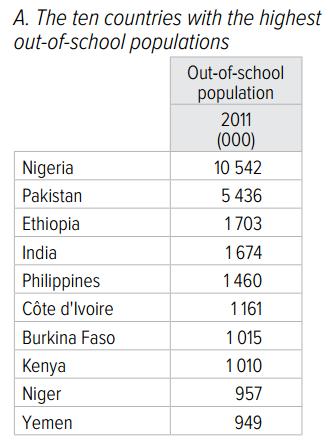Some Highlights from the Education for All Global Monitoring 2013/14 Report
Here are some figures, tables and excerpts from 2013/14 UNESCO Education for All Global Monitoring 2013/14 Report. These are especially relevant to the Philippines since the country is mentioned in this presentation (unfortunately, not in a positive light). The report goes beyond simple access to education, it now begins to address the quality of education. The report ends with a hopeful list of what can be done to address the global learning crisis and this list places the teacher in front to help solve the challenges.
First, the Philippines lands in the list of countries with the highest out-of-school children:
Inequality in education is markedly greater in the Philippines and continues to be an insurmountable challenge. Poor children are not able to finish school. This, of course, is only a question of access. In terms of quality, the inequality is only expected to be much more dramatic. As the report emphasizes, inequality in education has serious consequences:
"Differences in education inequality are one reason for the wide variations in growth rates among countries in the East Asia and the Pacific region over the past 40 years. The Republic of Korea reduced inequality in education 50% faster than countries such as the Philippines. This has resulted in very different paces of economic growth. Over the period, average annual growth in GDP per capita was 5.9% in the Republic of Korea but 1.5% in the Philippines." (Take note that the "per capita" number is used here and not the total GDP. True economic growth has to be felt by most members of society, not just the wealthiest, which is what total GDP hides.)
Poverty stifles education and malnutrition among young children, a more direct and reliable measure of poverty (not just some survey from some paid company), is still unfortunately high in so many countries including the Philippines:
So, what can be done. The following are the suggestions from the report and these are all dependent on teachers:
Sounds more like a wish list....
First, the Philippines lands in the list of countries with the highest out-of-school children:
Second, compared to Indonesia, the Philippines has shown smaller progress in achieving universal primary education.
Inequality in education is markedly greater in the Philippines and continues to be an insurmountable challenge. Poor children are not able to finish school. This, of course, is only a question of access. In terms of quality, the inequality is only expected to be much more dramatic. As the report emphasizes, inequality in education has serious consequences:
"Differences in education inequality are one reason for the wide variations in growth rates among countries in the East Asia and the Pacific region over the past 40 years. The Republic of Korea reduced inequality in education 50% faster than countries such as the Philippines. This has resulted in very different paces of economic growth. Over the period, average annual growth in GDP per capita was 5.9% in the Republic of Korea but 1.5% in the Philippines." (Take note that the "per capita" number is used here and not the total GDP. True economic growth has to be felt by most members of society, not just the wealthiest, which is what total GDP hides.)
Poverty stifles education and malnutrition among young children, a more direct and reliable measure of poverty (not just some survey from some paid company), is still unfortunately high in so many countries including the Philippines:
- Fill teacher gaps
- Attract the best candidates to teaching
- Train teachers to meet the needs of all children
- Prepare teacher educators and mentors to support teachers
- Get teachers to where they are needed most
- Use a competitive career and pay structure to retain the best teachers
- Improve teacher governance to maximize impact
- Equip teachers with innovative curricula to improve learning
- Develop classroom assessments to help teachers identify and support students at risk of not learning
- Provide better data on trained teachers
Sounds more like a wish list....



Comments
Post a Comment